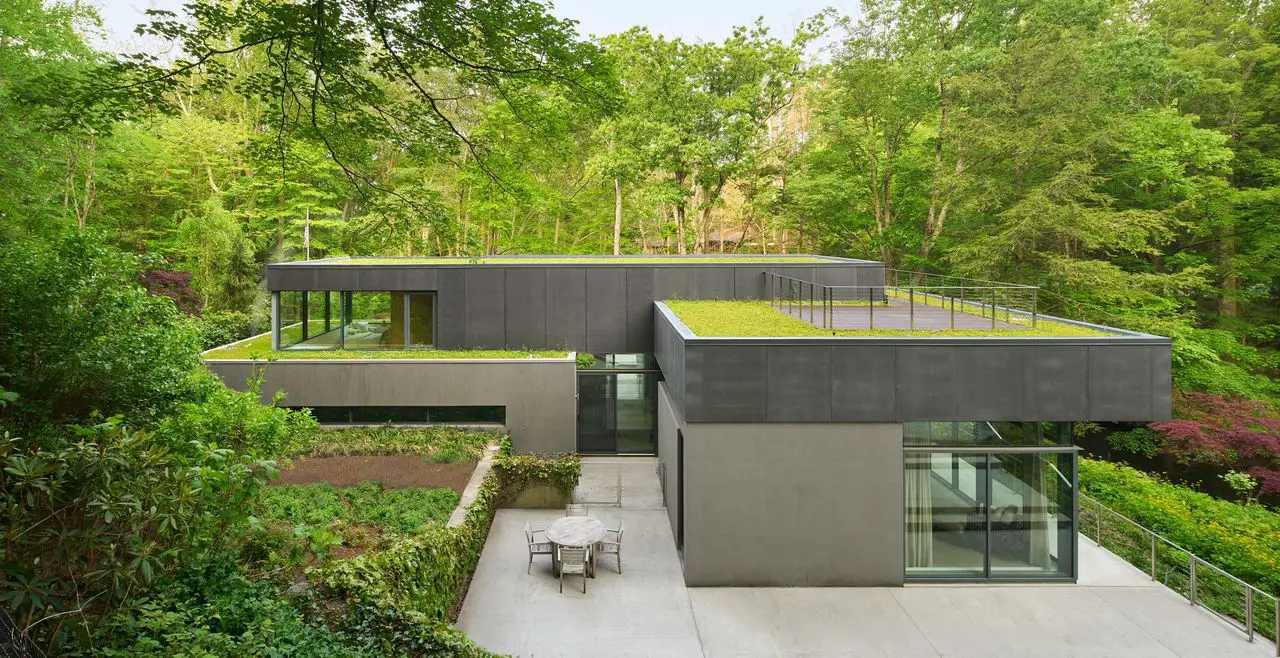Specht Architects: Green Roof, Green Woods

Specht Architects have created a home in a forest that fully respects its natural surroundings
By Chere Di Boscio
Imagine waking up every morning to the sound of birdsong, and the site of green canopies. That’s exactly how life would be if you lived in Specht Architects Weston Residence.
Nestled in an emerald-green valley adjacent to the Saugatuck River in Connecticut, this 2400 sq ft home takes advantage of its beautiful surroundings in a way that purposefully blurs the distinction between the built and natural environment.
You approach the house from a road that begins high-up on a cliff above. From there, you notice one key feature of the house: the roof scapes.
The 5th Facade
Called the ‘fifth façade’ by Specht Architects, this is a critical element of the design. This home’s multiple green roofs feature a green roof system that provides sustainable advantages. For example, the plants growing on the roof insulate the building for heat in winter, and offer cooler temperatures in summer. Thus, there’s no need for HVAC. Wondering what grows on the roof? It’s year-round, region-specific succulents.
Bedrooms project out into these roof gardens, giving a feeling of being fully immersed in the landscape. The planted roofs are also integral to the high-performance building envelope. Interior and exterior spaces merge through views, portals, and material continuity.
As with other glass houses, the landscape becomes a core feature for each room, playing with transparency during the day and reflectivity at night.
A River Runs Through It
But perhaps the most spectacular aspect of the natural world surrounding the house is the river. Consequently, the side of the house that faces it features floor-to-ceiling glazing, and clerestory windows wrap the rest of the interior, allowing the roof plane to float above the interior spaces.
The kitchen is an island that floats within the main living and dining space. And built-in cabinetry and appliances along the perimeter project a feeling of a serene space that integrates perfectly with the surrounding landscape.
The primary materials used by Specht Architects were cast-in-place concrete, with selected areas of cement-board panel. Large metallic window glazing units bound the house. Additionally, bamboo plywood panels form the interior walls, while the floors are polished concrete. A glass-backed fireplace provides added heat in winter.
All blinds, diffusers, and other devices are hidden in an integrated track that runs the perimeter of the house, leaving views unobstructed to the natural surroundings.
Here below, Scott Specht of Specht Architects tells us more about the Weston CT/green roof house.
It’s exceedingly difficult not to destroy forested areas around a construction site. How did you ensure your crew didn’t ruin all the surrounding trees?
On all of our projects, we consider tree protection to be of utmost importance. In collaboration with the landscape architect, we created a tree protection plan. This identifies all trees within the construction perimeter that are to be preserved, and specifies measures to be taken. This could include a fenced root protection zone, trunk/bark protection wrap, and irrigation protocols to make sure that the trees have the best chance of surviving the stresses of the construction process.
Why did you choose concrete for the main material?
We frequently work in concrete. Not only for its aesthetic possibilities, but for its natural durability, fire resistance, and low maintenance qualities. This site, being low and near a river, lent itself to a material that had fewer potential problems with flooding, decay, and deterioration.
The surrounding area is gorgeous, but seems environmentally sensitive. How did you manage to get access to the site without ruining the forest?
The site is interesting. It is beautiful and on the riverfront. But it’s also very close to and well below the level of a heavily trafficked local road. The drive into the site to the house location is very short, and works its way down a cliffside to reach the entry area. There was little vegetation on the cliff close to the road, so not much was disturbed in the process.
Given the natural beauty of the area, do you think adding a house to it will start a trend for development that might end up being the beginning of the end of the forest?
Although it isn’t very apparent from the aerial photos, the neighbourhood is long established. It’s a very developed town that is within commute distance to NYC. Virtually every property has a house on it, and most are a century (or more) old. Local development regulations are very strict. And our house, being relatively small and sensitive to the site was welcomed.
Besides the obvious aesthetics, what are the benefits of having a ‘green roof’?
The green roof is a natural climate moderator. It is an insulator and diffuser of direct sunlight. The moisture in the soil also allows for evaporative cooling on hot days, making the roof 30-40% cooler than a conventional roof.
The green roof also reduces stormwater runoff by about 65%. Finally, it attracts wildlife such as birds and bees!
What’s your favourite element of this construction?
I personally love the small second-level guest bedroom. It has glass on three sides, and a wraparound green roof at roughly waist level. It feels like you are in a cockpit in the forest, completely immersed in the natural landscape.
Project team:
Architect: Specht Architects with architect Louise Harpman
Contractor: Michael Greenberg & Associates
Landscape Architect: Heather Morgan
Liveroof Green Roof Systems
Image credits: Jasper Lazor











- 7 Tips For Garden Inspired Interior Decor - May 15, 2025
- What Is Vegan Art? And Why Does It Matter? - April 29, 2025
- 7 Tips & Bins For Composting At Home - March 26, 2025








